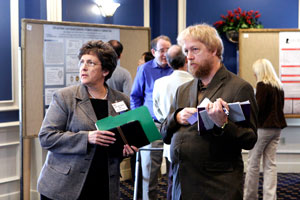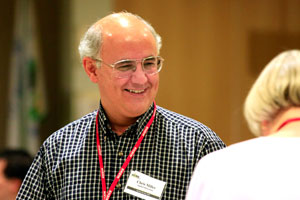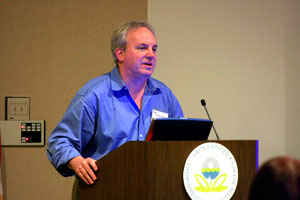
Environmental Factor, June 2008, National Institute of Environmental Health Sciences
Spring GEMS Meeting Focuses on MicroRNA
By Eddy Ball
June 2008






True to its quarter century tradition of highlighting new and emerging trends in biomedical research, the theme of the Genetics and Environmental Mutagenesis Society (GEMS) 2008 Spring Meeting was a topic of growing interest to environmental health sciences, “The Role of MicroRNA in Disease.” The group, meeting April 21 at the RTP headquarters of the U.S. Environmental Protection Agency (EPA), hosted presentations by five investigators working in Triangle-area labs at the cutting edge of microRNA research.
The meeting opened with remarks by GEMS(http://www.gems-nc.org/) ![]() President and NIEHS Associate Scientific Review Administrator RoseAnne McGee, who introduced GEMS President-Elect and EPA biochemist Jeff Ross, Ph.D. She also acknowledged the support provided by NIEHS and the group’s corporate sponsors, whose financial contributions have helped GEMS support the professional development of young researchers and expose them to new developments in biomedical research.
President and NIEHS Associate Scientific Review Administrator RoseAnne McGee, who introduced GEMS President-Elect and EPA biochemist Jeff Ross, Ph.D. She also acknowledged the support provided by NIEHS and the group’s corporate sponsors, whose financial contributions have helped GEMS support the professional development of young researchers and expose them to new developments in biomedical research.
According to Ross, who is acting director of the Environmental Carcinogenesis Division of the EPA National Health and Environmental Effects Research Laboratory, microRNA research is a relatively new field that is growing rapidly — from a handful of citations in PubMed prior to 2000, when the term was introduced, to more than 1,000 in 2007.
“It [microRNA] is one of the more important mechanisms for regulation of gene expression, and altered microRNA expression has been associated with a number of disease states,” Ross explained. “This is clearly a very important topic and one that we felt would be of special interest to our membership.”
Ross welcomed as panelists some of the leading researchers in the field of microRNA expression: University of North Carolina at Chapel Hill (UNC-CH) Cell and Developmental Biology Professor Scott Hammond, Ph.D.(http://www-cellbio.med.unc.edu/grad/depttest/hammond.htm) ![]() ; toxicologist Michael Mattie, Ph.D., a principal scientist in the GlaxoSmithKline Infectious Diseases Discovery Technology Group; UNC-CH School of Pharmacy Research Professor Clark Jeffries(http://www.pharmacy.unc.edu/faculty-research/faculty-directory/clark-jeffries/facultycv_publication_view)
; toxicologist Michael Mattie, Ph.D., a principal scientist in the GlaxoSmithKline Infectious Diseases Discovery Technology Group; UNC-CH School of Pharmacy Research Professor Clark Jeffries(http://www.pharmacy.unc.edu/faculty-research/faculty-directory/clark-jeffries/facultycv_publication_view) ![]() , Ph.D.; Duke University virologist and James B. Duke Professor Bryan Cullen(http://cmb.duke.edu/faculty/cullen.html)
, Ph.D.; Duke University virologist and James B. Duke Professor Bryan Cullen(http://cmb.duke.edu/faculty/cullen.html) ![]() , Ph.D.; and UNC-CH Cell and Developmental Biology Professor Da-Zhi Wang(http://www-cellbio.med.unc.edu/grad/depttest/wang.htm)
, Ph.D.; and UNC-CH Cell and Developmental Biology Professor Da-Zhi Wang(http://www-cellbio.med.unc.edu/grad/depttest/wang.htm) ![]() , Ph.D.
, Ph.D.
Hammond led off the presentations with an overview of microRNA biology, “The microRNA Pathway: Parallels between Development and Cancer,” that highlighted the enormous potential benefits of more completely understanding that biology. As Hammond observed at the beginning of his talk, microRNAs are single-stranded RNA molecules that down-regulate gene expression and play a role that is only beginning to be understood in such diseases as cancer, where gene silencing sets the stage for tumor development and growth.
“These microRNAs have been shown to be quite extensive,” Hammond continued. “In fact, in the mammalian genome, there are more than 700 microRNAs that have been identified.” Introducing a theme that his colleagues at the meeting would return to several times, he noted that “the sequences for each microRNA are different and they’re encoded in different parts of the genome.… The question is, ‘what are the messenger RNAs that are being regulated by microRNA?’”
The speakers who followed Hammond reported on findings of microRNA gene regulation related to several major diseases. Mattie presented data on microRNA alterations in breast and prostate cancer, where they may be useful as markers of disease and disease progression. Cullen explored the ways viruses, specifically Herpes and Kaposi’s sarcoma-associated herpevirus, can take advantage of microRNAs to inhibit host defense. The final speaker, Wang, discussed the role microRNAs play in transcriptional control of mammalian heart growth and differentiation as related to human cardiovascular disorders, such as cardiac hypertrophy and heart failure.
Like Hammond, each speaker called the audience’s attention to how much remains to be understood about microRNAs and their targets. One of the most telling titles of the day was the one chosen by Clark Jeffries, who outlined “Some Curious Mechanisms of miRNAs,” a talk that reassured students and trainees in the audience of the challenges and opportunities ahead if they should choose to pursue research in the field.
A GEMS Tradition — Showcasing Emerging Research Trends
By providing a forum for local and invited speakers focused on themes of current interest, the Spring and Fall GEMS meetings offer attendees an opportunity to participate, interact and become more knowledgeable about each other’s work. The spring half-day meetings feature presentations by senior investigators working in their own labs, while the day-long fall meetings combine talks by invited speakers with oral and poster presentations by trainees. Each fall the organization awards cash prizes to the most outstanding talks and posters, allowing trainees expanded opportunities for travel to meetings and other professional and career development events.
The themes of previous meetings offer additional examples of the GEMS tradition:
- 24th Annual Fall Meeting in October 2006 — “Oxidative Stress and Damage” (see December 2006 Environmental Factor (http://www.niehs.nih.gov/news/newsletter/2006/2006dec.pdf)
 (6.5MG) featuring talks by University of South Alabama College of Medicine cellular biologist Susan LeDoux, Ph.D.; UNC-CH toxicologist James Swenberg, D.V.M.; and University of Illinois at Urbana-Champaign microbiologist James Imlay, Ph.D.
(6.5MG) featuring talks by University of South Alabama College of Medicine cellular biologist Susan LeDoux, Ph.D.; UNC-CH toxicologist James Swenberg, D.V.M.; and University of Illinois at Urbana-Champaign microbiologist James Imlay, Ph.D. - Spring Meeting in April 2007 — “Integrative Bioinformatics: Systems Biology Approaches to Genetics, Metabolism and Disease” (see May 2007 Environmental Factor (http://www.niehs.nih.gov/news/newsletter/2007/2007may.pdf)
 (9.7MB) with NIEHS Program Analysis Branch Chief and Senior Investigator Ben Van Houten, Ph.D.; NIEHS Associate Director and Director of the Office of Risk Assessment and Analysis Chris Portier, Ph.D.; UNC-CH DNA experimental pathologist William Kaufmann, Ph.D.; and Duke University biologist Paul Magwene, Ph.D.
(9.7MB) with NIEHS Program Analysis Branch Chief and Senior Investigator Ben Van Houten, Ph.D.; NIEHS Associate Director and Director of the Office of Risk Assessment and Analysis Chris Portier, Ph.D.; UNC-CH DNA experimental pathologist William Kaufmann, Ph.D.; and Duke University biologist Paul Magwene, Ph.D. - 25th Annual Fall Meeting in December 2007 — “Current and Future Issues in Environmental Toxicology” (see January 2008 Environmental Factor(http://www.niehs.nih.gov/news/newsletter/2007/december/gems.cfm)) featuring presentations by Duke University Professor of Radiation Oncology Randy Jirtle, Ph.D., on epigenetics; Woodrow Wilson International Center for Scholars science advisor Andrew Maynard, Ph.D., on nanomaterials; and EPA National Center for Computational Toxicology investigator Ann Richards, Ph.D., on the Distributed Structure-Searchable Toxicity (DSSTox) Database Network project.
"First Director of NIEHS..." - previous story ![]()
![]() next story - "Duke-HHMI Researcher..."
next story - "Duke-HHMI Researcher..."
June 2008 Cover Page



